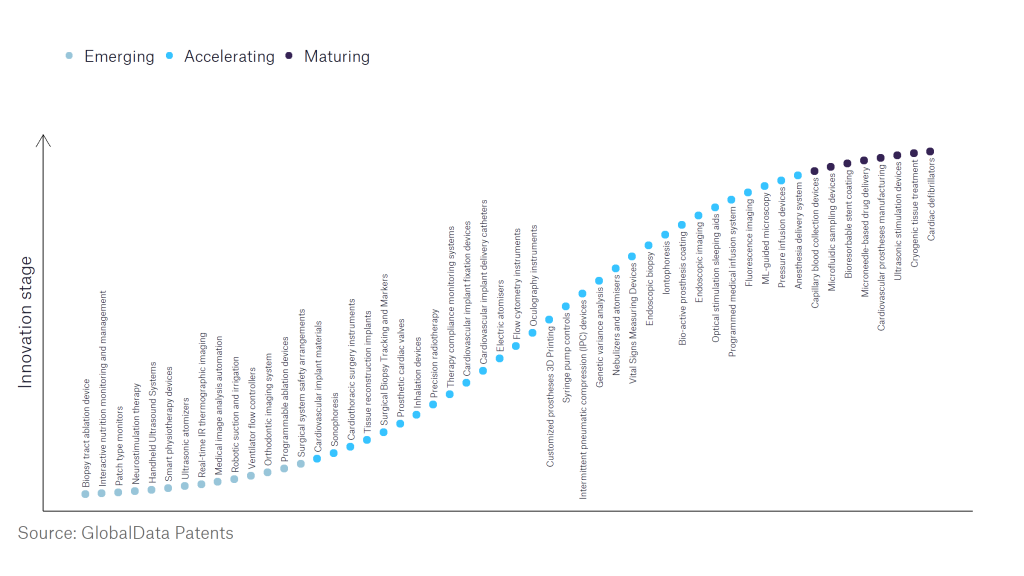<!–
–>
The Medical Devices industry continues to be a hotbed of innovation, with activity driven by increased need for homecare, preventative treatments, early diagnosis, reducing patient recovery times and improving outcomes, as well as a growing importance of technologies such as machine learning, augmented reality, 5G and digitalisation. In the last three years alone, there have been over 450,000 patents filed and granted in the Medical Devices industry, according to GlobalData’s report on Innovation in Medical Devices: Endoscopic biopsy.
However, not all innovations are equal and nor do they follow a constant upward trend. Instead, their evolution takes the form of an S-shaped curve that reflects their typical lifecycle from early emergence to accelerating adoption, before finally stabilising and reaching maturity.
Identifying where a particular innovation is on this journey, especially those that are in the emerging and accelerating stages, is essential for understanding their current level of adoption and the likely future trajectory and impact they will have.
150+ innovations will shape the Medical Devices industry
According to GlobalData’s Technology Foresights, which plots the S-curve for the Medical Devices industry using innovation intensity models built on over 550,000 patents, there are 150+ innovation areas that will shape the future of the industry.
Within the emerging innovation stage, neurostimulation therapy, smart physiotherapy devices, and real-time IR thermographic imaging are disruptive technologies that are in the early stages of application and should be tracked closely. Precision radiotherapy, electric atomisers, and bio-active prosthesis coating are some of the accelerating innovation areas, where adoption has been steadily increasing. Among maturing innovation areas are bioresorbable stent coating and cryogenic tissue treatment, which are now well established in the industry.
Innovation S-curve for the Medical Devices industry

Endoscopic biopsy is a key innovation area in the Medical Devices industry
Endoscopic biopsy is performed through a natural body orifice or a small incision using a fibre-optic endoscope (a long, thin tube with a close-focusing telescope on the end for viewing). The endoscope is used to examine the organ in question for abnormal or suspicious regions before removing a tiny sample of tissue for analysis. Endoscopic procedures are called for the organ or area of the body that will be viewed and/or treated.
The endoscope can be put into one’s body by a tiny incision or through any entrance in the body, including the mouth, nose, rectum, or urethra. Endoscopies typically take five to 20 minutes.
GlobalData’s analysis also uncovers the companies at the forefront of each innovation area and assesses the potential reach and impact of their patenting activity across different applications and geographies. According to GlobalData, there are 60 companies, spanning technology vendors, established Medical Devices companies, and up-and-coming start-ups engaged in the development and application of endoscopic biopsy.
Key players in endoscopic biopsy – a disruptive innovation in the Medical Devices industry
‘Application diversity’ measures the number of different applications identified for each relevant patent and broadly splits companies into either ‘niche’ or ‘diversified’ innovators.
‘Geographic reach’ refers to the number of different countries each relevant patent is registered in and reflects the breadth of geographic application intended, ranging from ‘global’ to ‘local’.
Patent volumes related to endoscopic biopsy
Source: GlobalData Patent Analytics
Johnson & Johnson is one of the leading patent filers in the field of endoscopic biopsy. Some other key patent filers in the field include Waters, Medtronic, Olympus, and Boston Scientific.
In terms of application diversity, ConMed leads the pack, followed by Avalo Therapeutics and Waters. By means of geographic reach, Massachusetts General Hospital held the top position, followed by Axis Surgical Technologies and Waters.
The development of new imaging technologies that allow clinicians to go beyond basic anatomical features to grasp biological activity is crucial to the future of endoscopy. Tissue molecular characteristics include a lot of information that gives specifics about tissue activity that can be identified when scanned appropriately. The rise in technological advancements and the rise in the prevalence rate of diseases requiring endoscopy are the primary factors driving market growth of endoscopic biopsy.
To further understand the key themes and technologies disrupting the Medical Devices industry, access GlobalData’s latest thematic research report on Medical Devices.
- SEO Powered Content & PR Distribution. Get Amplified Today.
- Platoblockchain. Web3 Metaverse Intelligence. Knowledge Amplified. Access Here.
- Source: https://www.medicaldevice-network.com/data-insights/innovators-endoscopic-biopsy-medical-devices/



